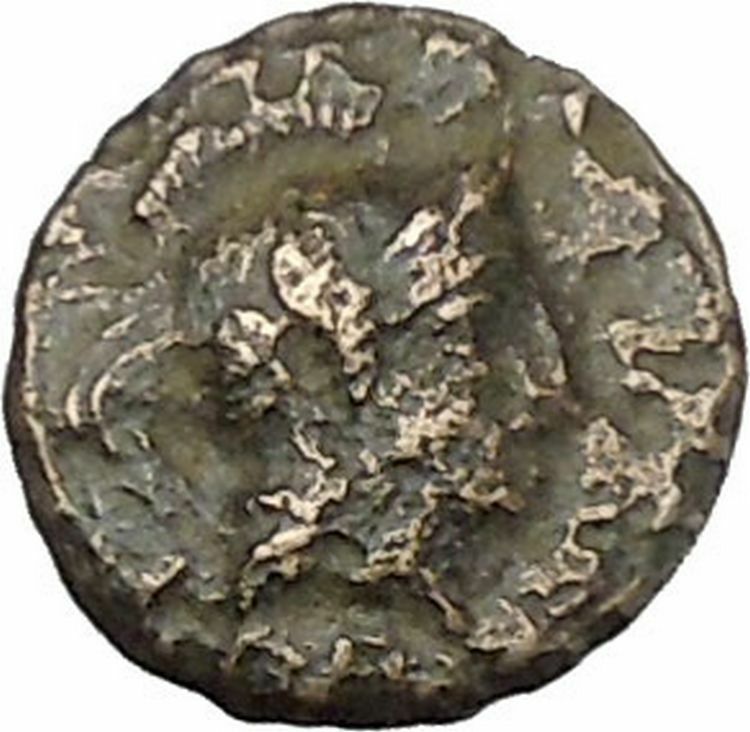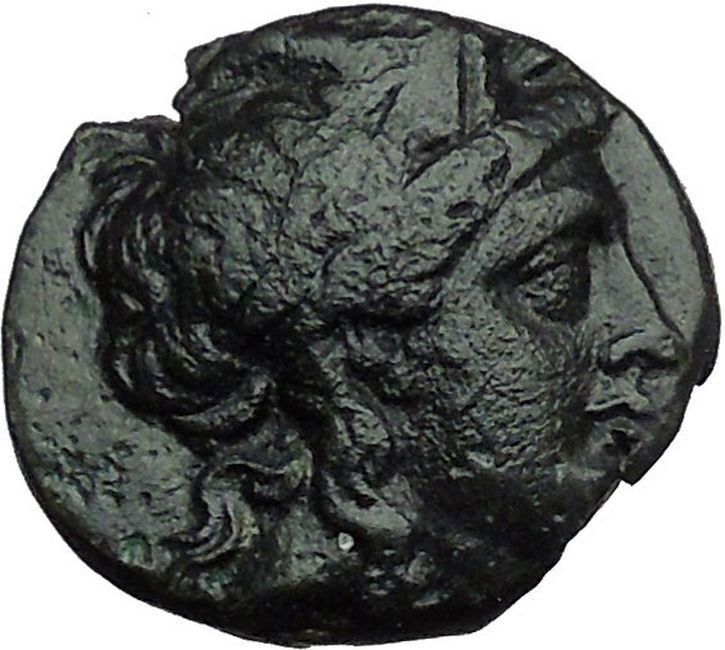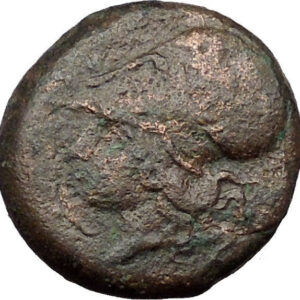|
Greek city of Magnesia ad Maeandrum in Ionia
Bronze 14mm (3.50 grams) Struck 2nd-1st centuries B.C.
Nikanor and Zopyros, magistrates.
Reference: SNG Copenhagen 855
Laureate head of Artemis right, quiver over shoulder.
ΜΑΓΝΗΤΩΝ / ΝΙΚΑΝΩΡ ΚΑΙ / ZΩΠΥΡΟΣ, Cult statue of Artemis Leukophryene standing facing, monogram in field right.
Situated south-east of Ephesus, on a tributary of the Maeander, Magnesia was originally founded from Thessaly but was re-established by colonists from Miletos in the 7th century B.C.
The new town which Strabo saw was remarkable for its temple of Artemis Leucophryeno, which in size and the number of its treasures was surpassed by the temple of Ephesus, but in beauty and the harmony of its parts was superior to all the temples in Asia Minor. The temple to Artemis is said by Vitruvius to have been built by the architect Hermogenes, in the Ionic style.
You are bidding on the exact item pictured, provided with a Certificate of Authenticity and Lifetime Guarantee of Authenticity.
Artemis was one of the most widely venerated of the Ancient Greek deities. Some scholars believe that the name, and indeed the goddess herself, was originally pre-Greek. Homer refers to her as Artemis Agrotera, Potnia Theron “Artemis of the wildland, Mistress of Animals”. In the classical period of Greek mythology, Artemis (Greek: (nominative) Ἄρτεμις, (genitive) Ἀρτέμιδος) was often described as the daughter of Zeus and Leto, and the twin sister of Apollo. She was the Hellenic goddess of the hunt, wild animals, wilderness, childbirth, virginity and young girls, bringing and relieving disease in women; she often was depicted as a huntress carrying a bow and arrows. The deer and the cypress were sacred to her. In later Hellenistic times, she even assumed the ancient role of Eileithyia in aiding childbirth. described as the daughter of Zeus and Leto, and the twin sister of Apollo. She was the Hellenic goddess of the hunt, wild animals, wilderness, childbirth, virginity and young girls, bringing and relieving disease in women; she often was depicted as a huntress carrying a bow and arrows. The deer and the cypress were sacred to her. In later Hellenistic times, she even assumed the ancient role of Eileithyia in aiding childbirth.
Artemis later became identified with Selene, a Titaness who was a Greek moon goddess, sometimes depicted with a crescent moon above her head. She was also identified with the Roman goddess Diana, with the Etruscan goddess Artume, and with the Greek or Carian goddess Hecate.
 Interest in Hermogenes of Priene (late 3rd – early 2nd century BCE), the Hellenistic architect of a temple of Artemis Leukophryene (Artemision) at Magnesia in Lydia, an Ionian colony on the banks of the Maeander river in Anatolia, has been sparked by references to his esthetic made by the 1st-century Roman architect Vitruvius (De Architectura, books iii, 2 and 6). Interest in Hermogenes of Priene (late 3rd – early 2nd century BCE), the Hellenistic architect of a temple of Artemis Leukophryene (Artemision) at Magnesia in Lydia, an Ionian colony on the banks of the Maeander river in Anatolia, has been sparked by references to his esthetic made by the 1st-century Roman architect Vitruvius (De Architectura, books iii, 2 and 6).
Hermogenes’ rules on symmetry and proportion define what Vitruvius calls “eustyle” (eu stylos “right column”), an architectural ideal that prescribed a series of proportional relationships for temples that was all derived from the diameter of the column, as a module or unit of measure. Ideal “eustyle” intercolumniation (the space between the columns) should be two-and-a-quarter column-thicknesses, and the height of the Ionic column nine-and-a-half times its diameter. If the intercolumniation was to be tighter, columns should be taller in their proportions, and thicker if they were farther spaced. It is this sense of rational relations that Vitruvius is expressing when he writes “in the members of a temple there ought to be the greatest harmony in the symmetrical relations of the different parts to the general magnitude of the whole.” One element in a classical system cannot be changed without changing the other proportions too.
The geographer Strabo mentions this temple, the third greatest temple after those in Didyma and Ephesus, but considered finest of all for its proportions.
Consequently, archaeologists have been curious to rediscover the site of Hermogenes’ temple, traces of which are not apparent. Even the site of the colony of the mother-city of Magnesia in Thessaly was not established until W. M. Leake got the site correctly identified in 1824 (Journal of a Tour in Asia Minor pp 242ff). In the winter of 1842-3, a French team struggled with swampy ground and a high water table at the heavily sedimented site, and succeeded in removing 40 meters of the temple’s frieze, comprising 41 blocks, and some other architectural elements. These were taken to the Louvre Museum, but the excavations were never published. In 1887 Osman Hamdi Bey, director of the Archaeological Museums of Constantinople, carried off to Constantinople a further 20 meters of frieze blocks from the Artemision. More rigorous excavations at Magnesia were undertaken by the German Institute at Constantinople in the 1890s and by German and Turkish scholars since 1984. The result is that sculptural elements of Hermogenes’ Artemision are scattered among the Pergamum Museum, Berlin, the Louvre Museum, Paris and Istanbul.
Since the 1980s, enough remnants of the U-shaped raised colonnaded altar that faced the temple have been recovered to permit modern reconstructions of its original appearance, for the first time since Antiquity.
Hermogenes was the architect of the hexastyle peripteral Temple of Dionysus in Teos, also mentioned by Vitruvius. It was the largest temple to Dionysus in the ancient world; only the platform (stylobate) remains, measuring 18.5 by 35 meters (61 by 115 feet). It is in the western part of the lower city, against the walls. It was constructed early in the 2nd century BCE and later reconsecrated to the cult of Tiberius and partly rebuilt during Hadrian’s reign. The temple has been excavated by a team of the University of Ankara.
Hermogenes also appears to have written a text, no longer extant, on his symmetrical principles. (De Architectura 3.3.9)
Magnesia or Magnesia on the Maeander (Ancient Greek: Μαγνησία ἡ πρὸς Μαιάνδρῳ or Μαγνησία ἡ ἐπὶ Μαιάνδρῳ; Latin: Magnesia ad Maeandrum) was an ancient Greek city in Ionia, considerable in size, at an important location commercially and strategically in the triangle of Priene, Ephesus and Tralles. The city was named Magnesia, after the Magnetes from Thessaly who settled the area along with some Cretans. It was later called “on the Meander” to distinguish it from the nearby Lydian city Magnesia ad Sipylum.
The territory around Magnesia was extremely fertile, and produced excellent wine, figs, and cucumbers. It was built on the slope of Mount Thorax, on the banks of the small river Lethacus, a tributary of the Maeander river upstream from Ephesus. It was 15 miles from the city of Miletus. The ruins of the city are located west of the modern village Tekin in the Germencik district of Aydın Province, Turkey.
Magnesia lay within Ionia, but because it had been settled by Aeolians from Greece, was not accepted into the Ionian League. Magnesia may have been ruled for a time by the Lydians, and was for some time under the control of the Persians, and subject to Cimmerian raids. In later years, Magnesia supported the Romans in the Second Mithridatic War.
General history
Magnesia soon attained great power and prosperity, so as to be able to cope even with a challenge from Ephesus. However, the city was taken and destroyed by the Cimmerians, some time between 726 BC and 660 BC. The deserted site was soon reoccupied, and rebuilt by the Milesians or, according to Athenaeus, by the Ephesians. The Persian satraps of Lydia also occasionally resided in the place.
In the fifth century BC, the exiled Athenian Themistocles came to Persia to offer his services to Artaxerxes, and was given control of Magnesia to support his family.
The name “magnet” may come from lodestones found in Magnesia.
In the time of the Romans, Magnesia was added to the kingdom of Pergamus, after Antiochus had been driven eastward beyond Mount Taunts. After this time the town seems to have declined and is rarely mentioned, though it is still noticed by Pliny and Tacitus. Hierocles ranks it among the bishoprics of Asia, and later documents seem to imply that at one time it bore the name of Maeandropolis. The existence of the town in the time of the emperors Aurelius and Gallienus is attested to by coins.
Landmarks
Magnesia contained a temple of Dindymene, the mother of the gods; the wife or daughter of Themistocles, was said to have been a priestess of that divinity.
Strabo later noted the temple no longer existed, the town having been transferred to another place. The change in the site of the town alluded to by Strabo, is not noticed by other contemporary authors, however some suggest that Magnesia was moved from the banks of the Meander to a place at the foot of Mount Thorax three miles from the river.
The new town which Strabo saw was remarkable for its temple of Artemis Leucophryeno, which in size and the number of its treasures was surpassed by the temple of Ephesus, but in beauty and the harmony of its parts was superior to all the temples in Asia Minor. The temple to Artemis is said by Vitruvius to have been built by the architect Hermogenes, in the Ionic style.
Little remains of either temple today. The site of Magnesia on the Maeander was once identified with the modern Guzel-kissar; since then the ruins of a temple to Artemis were found at Inck-bazar, and the latter is considered a more likely site.
Modern excavations
The first excavations at the archaeological site were performed during 1891 and 1893 by a German archaeological team conducted by Carl Humann, discoverer of the Pergamon Altar. These lasted 21 months and partially revealed the theatre, the Artemis temple, the agora, the Zeus temple and the prytaneion. Excavations were resumed at the site, after an interval of almost 100 years, in 1984, by Orhan Bingöl of the University of Ankara and the Turkish Ministry of Culture.
Findings from the site are now displayed in Istanbul and Aydın, as well as in Berlin and Paris. Copies of the portico (pronaos) of the Zeus temple and of a bay of the Artemis temple can be visited in the Pergamonmuseum in Berlin. The most of the architectural remains of Magnesia have been destroyed by local lime burners. The well preserved remains of the Zeus temple have been destroyed by local residents even after Humann’s excavation campaign.
Notable people
- Bathycles (6th century BC) Greek sculptor
- Themistocles of Athens spent his final years and was buried here
Sources
- Carl Humann: Magnesia am Maeander. Bericht über die Ergebnisse der Ausgrabungen der Jahre 1891–1893. Berlin: Reimer, 1904
- Volker Kästner: Der Tempel des Zeus Sosipolis von Magnesia am Mäander, in: Brigitte Knittlmayer and Wolf-Dieter Heilmeyer: Die Antikensammlung, Mainz: Philipp von Zabern, 1998, p. 230-231
- Johannes Althoff: Ein Meister des Verwirklichens. Der Archäologe Theodor Wiegand, in: Peter Behrens, Theodor Wiegand und die Villa in Dahlem. Klaus Rheidt and Barbara A. Lutz (ed.), Mainz: Philipp von Zabern, 2004, p. 151
Literary references
- Magnesia on the Maeander is the location for the historical mystery novel The Ionia Sanction, by Gary Corby, set during the last days of Themistocles.
References
- General
- In Smith, W. (1854). Dictionary of Greek and Roman geography. Boston: Little, Brown & Co Page 252
|





 described as the daughter of Zeus and Leto, and the twin sister of Apollo. She was the Hellenic goddess of the hunt, wild animals, wilderness, childbirth, virginity and young girls, bringing and relieving disease in women; she often was depicted as a huntress carrying a bow and arrows. The deer and the cypress were sacred to her. In later Hellenistic times, she even assumed the ancient role of Eileithyia in aiding childbirth.
described as the daughter of Zeus and Leto, and the twin sister of Apollo. She was the Hellenic goddess of the hunt, wild animals, wilderness, childbirth, virginity and young girls, bringing and relieving disease in women; she often was depicted as a huntress carrying a bow and arrows. The deer and the cypress were sacred to her. In later Hellenistic times, she even assumed the ancient role of Eileithyia in aiding childbirth. Interest in Hermogenes of Priene (late 3rd – early 2nd century BCE), the Hellenistic architect of a temple of Artemis Leukophryene (Artemision) at Magnesia in Lydia, an Ionian colony on the banks of the Maeander river in Anatolia, has been sparked by references to his esthetic made by the 1st-century Roman architect Vitruvius (De Architectura, books iii, 2 and 6).
Interest in Hermogenes of Priene (late 3rd – early 2nd century BCE), the Hellenistic architect of a temple of Artemis Leukophryene (Artemision) at Magnesia in Lydia, an Ionian colony on the banks of the Maeander river in Anatolia, has been sparked by references to his esthetic made by the 1st-century Roman architect Vitruvius (De Architectura, books iii, 2 and 6).




